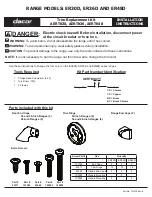
INSTALLATION - 49
91477A593/C
e
INSTALLATION
Gas connection
Connection to the gas mains can be made using
a continuous wall steel hose in compliance with
the guidelines established by the standards in
force. To use other types of gas, see the chapter
“Adaptation to different types of gas”. The gas
inlet connection is threaded ½” external gas
(ISO 228-1).
Connection with a rubber hose
Verify that all following conditions are met:
• The hose is attached to the hose connector
with safety clamps
• No part of the hose is in contact with hot
walls (max. 50 °C)
• The hose is not under traction or tension and
has no kinks or twists
• The hose is not in contact with sharp objects
or sharp corners
• If the hose is not perfectly airtight and leaks
gas, do not try to repair it; replace it with a
new hose
• verify that the hose is not past its expiry date
(serigraphed on the hose itself).
Make the connection to the gas mains using a
rubber hose whose specifications comply with
current standards (verify that the reference
standard is stamped on the hose).
Carefully screw the hose connector 3 onto the
appliance’s gas connector 1 (½” thread ISO
228-1), placing the seal 2 between them. Hose
connector 4 can also be screwed to hose
connector 3, depending on the diameter of the
gas hose used.
After tightening the hose connector(s), push gas
hose 6 onto the hose connector and secure it
with the clamp 5, which must be compliant with
current regulations.
Connection with a steel hose
Make the connection to the gas mains using a
continuous wall steel hose whose specifications
comply with the applicable standard.
Carefully screw the connector 3 to the gas
The appliance must be installed by a
qualified technician and according to
the regulations in force.
See General safety instructions.
Connection using a rubber hose
complying with current standards is only
permitted if the hose can be inspected
along its entire length.
ü
ü
The inside diameter of the hose must be
8 mm for LPG and 13 mm for Natural
gas and Town gas.
1
2
5
6
3
3
4
2
1
3








































